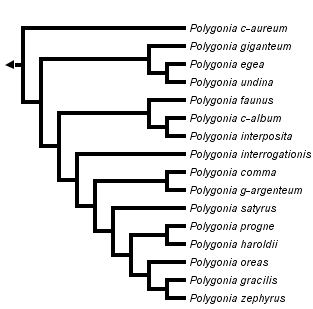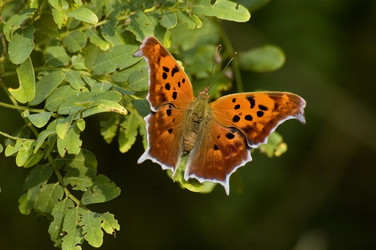Polygonia
Anglewings
Niklas Wahlberg and Andrew V. Z. Brower


This tree diagram shows the relationships between several groups of organisms.
The root of the current tree connects the organisms featured in this tree to their containing group and the rest of the Tree of Life. The basal branching point in the tree represents the ancestor of the other groups in the tree. This ancestor diversified over time into several descendent subgroups, which are represented as internal nodes and terminal taxa to the right.

You can click on the root to travel down the Tree of Life all the way to the root of all Life, and you can click on the names of descendent subgroups to travel up the Tree of Life all the way to individual species.
For more information on ToL tree formatting, please see Interpreting the Tree or Classification. To learn more about phylogenetic trees, please visit our Phylogenetic Biology pages.
close boxIntroduction
The genus Polygonia is holarctic. The adult wings have strongly crenulated margins with brownish patterns on the underside that render the butterflies virtually invisible when they land on dead leaves. Several species, such as P. interrogationis, overwinter as adults and may be seen flying in the early spring before any leaves are present on the trees.
Discussion of Phylogenetic Relationships
The topology is based on the combined analysis of nuclear and mitochondrial genes by Wahlberg et al. (2009, their Fig. 1). There is some conflict between topologies implied by the mtDNA in contrast to the nuclear genes, but this tree represents the most parsimonious arrangement of the taxa based on all the data available, and therefore the preferred hypothesis of relationships for the time being.References
Wahlberg N, Brower AVZ, and Nylin S. 2005. Phylogenetic relationships of tribes and genera in the subfamily Nymphalinae ((Lepidoptera: Nymphalidae) based on three gene sequences. Biol. J. Linn. Soc. 86: 227-251.
Wahlberg N, and Nylin S. 2003. Morphology versus molecules: resolution of the positions of Nymphalis, Polygonia, and related genera (Lepidoptera: Nymphalidae). Cladistics 19: 213-223.
Wahlberg, N., Weingartner, E., Warren, A. D. & Nylin, S. 2009 Timing major conflict between mitochondrial and nuclear genes in species relationships of Polygonia butterflies (Nymphalidae: Nymphlalini). BMC Evolutionary Biology 9, 92.
Title Illustrations

| Scientific Name | Polygonia comma |
|---|---|
| Location | Valley Forge National Park, Pennsylvania, USA |
| Specimen Condition | Live Specimen |
| Source | One Last Look |
| Source Collection | Flickr |
| Image Use |
 This media file is licensed under the Creative Commons Attribution-NonCommercial-NoDerivs License - Version 2.0. This media file is licensed under the Creative Commons Attribution-NonCommercial-NoDerivs License - Version 2.0.
|
| Copyright | © 2006 Marty DeAngelo |
| Scientific Name | Polygonia interrogationis |
|---|---|
| Location | Palmyra Cove Nature Park, Palmyra, New Jersey, USA |
| Specimen Condition | Live Specimen |
| Source | Unquestionable Beauty |
| Source Collection | Flickr |
| Image Use |
 This media file is licensed under the Creative Commons Attribution-NonCommercial-NoDerivs License - Version 2.0. This media file is licensed under the Creative Commons Attribution-NonCommercial-NoDerivs License - Version 2.0.
|
| Copyright | © 2006 Marty DeAngelo |
About This Page
Niklas Wahlberg

University of Turku, Finland

Middle Tennessee State University, Murfreesboro, Tennessee, USA
Correspondence regarding this page should be directed to Niklas Wahlberg at and Andrew V. Z. Brower at
Page copyright © 2009 Niklas Wahlberg and
 Page: Tree of Life
Polygonia . Anglewings.
Authored by
Niklas Wahlberg and Andrew V. Z. Brower.
The TEXT of this page is licensed under the
Creative Commons Attribution License - Version 3.0. Note that images and other media
featured on this page are each governed by their own license, and they may or may not be available
for reuse. Click on an image or a media link to access the media data window, which provides the
relevant licensing information. For the general terms and conditions of ToL material reuse and
redistribution, please see the Tree of Life Copyright
Policies.
Page: Tree of Life
Polygonia . Anglewings.
Authored by
Niklas Wahlberg and Andrew V. Z. Brower.
The TEXT of this page is licensed under the
Creative Commons Attribution License - Version 3.0. Note that images and other media
featured on this page are each governed by their own license, and they may or may not be available
for reuse. Click on an image or a media link to access the media data window, which provides the
relevant licensing information. For the general terms and conditions of ToL material reuse and
redistribution, please see the Tree of Life Copyright
Policies.
- First online 11 March 2007
- Content changed 04 June 2009
Citing this page:
Wahlberg, Niklas and Andrew V. Z. Brower. 2009. Polygonia . Anglewings. Version 04 June 2009 (under construction). http://tolweb.org/Polygonia/70340/2009.06.04 in The Tree of Life Web Project, http://tolweb.org/









 Go to quick links
Go to quick search
Go to navigation for this section of the ToL site
Go to detailed links for the ToL site
Go to quick links
Go to quick search
Go to navigation for this section of the ToL site
Go to detailed links for the ToL site